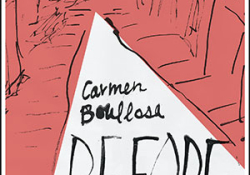Texas by Carmen Boullosa
Mexico City. Alfaguara. 2013. ISBN 9786071123688
 Through the intricate plot and multitude of characters, both principal and peripheral, Carmen Boullosa’s novel Texas seems to score a direct hit. The subtitle, La Gran Ladronería en el Lejano Norte (The greatest theft in the far north), speaks to the deep-seated feelings of frustration, anger, and indignation Mexicans held and still hold regarding the heavy-handed treatment meted out to them during the United States’ territorial expansion west and south during the eighteenth and nineteenth centuries. These emotional feelings rising from injustices suffered at the time, and since, give substance to the totality of this novel.
Through the intricate plot and multitude of characters, both principal and peripheral, Carmen Boullosa’s novel Texas seems to score a direct hit. The subtitle, La Gran Ladronería en el Lejano Norte (The greatest theft in the far north), speaks to the deep-seated feelings of frustration, anger, and indignation Mexicans held and still hold regarding the heavy-handed treatment meted out to them during the United States’ territorial expansion west and south during the eighteenth and nineteenth centuries. These emotional feelings rising from injustices suffered at the time, and since, give substance to the totality of this novel.
The gringo sheriff, Shears, beats a drunken Mexican farmworker. When Nepomuceno, a native-born landowner, intercedes, Shears insults Nepomuceno. Nepomuceno reacts, shooting Shears in the thigh and then hightailing it out of town. This incident sparks the flames of discord between North American invaders and Mexican landowners, flames that then leap back and forth across the Río Bravo (or Río Grande, depending on which narrative voice is speaking), whipping up animosity where there is none, and causing defensive action where none is called for, finally leading to the only possible dénouement given the superior forces of the northerners. The fast-paced action of the early part of the novel and the equally speedy conclusion of the piece are exciting narrative experiences. But the slow and somewhat pedantic minutiae of the two hundred pages that make up the rest of the novel are distracting, fragmented, and detract from the full enjoyment of Boullosa’s sardonic style.
Given the fact that this incident is symbolic of countless similar insults, offenses, murderous revenges, and outright illegal and unjust actions during the long centuries of discord along the Mexican border with the United States, it would have been a more fulfilling narrative experience had there been less distraction, fewer excursions into irrelevant tangents, and a more focused, direct explanation of the happenstances of the incident with its resultant resolutions. Carmen Boullosa has written a novel based upon historical facts, and she uses adroit and clever language. She is on point with her witty descriptions that introduce the tragedy and conclude the same. Yet the plot tends to get lost in the central plains of her novel, which detracts from a satisfying reading experience.
Janet Mary Livesey
University of Oklahoma





